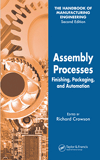
By law, all new cars, pickups, SUVs and vans must have air bags to protect the driver and front passenger. Automakers haven’t stopped there, however. Many vehicles are equipped with additional air bags for knee protection, side impacts, roll-overs and rear passengers. Considering that U.S. automakers assemble 12 million vehicles annually, that’s a lot of air bags. That kind of volume calls for high-speed automation, and machine builders are meeting the challenge.
Besides the air bag module, an air bag system consists of crash sensors, passenger sensors, a control unit, seat belt pretensioners, a warning light and a wire harness to link them all together. The module is a plastic or metal housing containing the nylon bag, an inflator and electrical connectors. The inflator holds gas-generating agents and one or two igniters to set them off.
The module is typically put together with a mix of manual and semiautomatic processes. “Our shop consists of U-shaped cells,” says Doug Bassett, an engineer at Autoliv’s facility in Brigham City, UT, where air bag modules are assembled. “Some machines have dial tables, but there’s nothing like a fully automatic line. Our cycle time is around 8 seconds.”
It’s the small components, like the inflator and sensors, that are assembled with high-speed automation. The cycle time for these systems is 2 to 3 seconds. For example, CL Automation (Machesney Park, IL) recently built a 13-station asynchronous system that assembles 1,350 igniters per hour. A conveyor shuttles assemblies from station to station on pallets, which carry 10 igniters each.
At the first station, ferrite beads are loaded onto the pallets. At the second station, a pin is formed and inserted into each igniter. At subsequent stations, two wires are welded onto the assemblies. Vision systems inspect the parts after each step, and rejects are destroyed immediately on-line. In addition, the machine automatically unloads a sampling of assemblies periodically for pull testing.
Air bags are assembled with a variety of processes, including welding, clinching and riveting. Igniters are welded with a pulsed Nd:YAG laser delivered through fiber optics. The laser creates a hermetic seal and provides strict control over the depth and width of the weld. Orbital forming is used to crimp and seal the ends of aluminum inflator tubes. High pressure is not required, so the tubes are not deformed and they can be sealed while fully charged. The process is also used to rivet the housings.
Of all the processes for assembling air bags, the trickiest is measuring and dispensing the gas-generating agents, says Bassett. This must be done precisely. Because of the volatility and toxicity of the chemicals, the task is accomplished with automatic equipment in an enclosed space.
Reliability is paramount with air bags, so the devices are rigorously inspected during assembly. Machine vision is critical for catching defects at line speeds. For example, vision systems are used to:
- find faulty parts and missing pin connections in igniters.
- measure critical dimensions on detonator contacts.
- detect missing washers in inflator canisters.
- check the presence, location and diameter of holes in the module housing, which govern how quickly the bag inflates.
Machine vision isn’t the only inspection technology used on air bags. Helium mass spectrometers detect tiny leaks in inflation modules. X-ray inspection systems check finished assemblies for completeness and loose parts that could turn into projectiles should the bags ever deploy.





